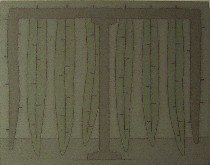 If you’re on overload from the simplistic approach to the politics that are bombarding us daily on the tv screen, the telephone, the email, and wherever you walk, you might appreciate the delicacy of choices in “The Color Green Exhibition” at the Esther Klein Gallery.
If you’re on overload from the simplistic approach to the politics that are bombarding us daily on the tv screen, the telephone, the email, and wherever you walk, you might appreciate the delicacy of choices in “The Color Green Exhibition” at the Esther Klein Gallery.
The show mostly steers clear of save-the-environment didactics while still touching on green planet issues–and so much more.
The 11-artist show has wit, variety, beauty, and deep thoughts, and I’m not talking Jacques Cousteau and the dolphins here.
John Dilg‘s oil paintings are greenish monochromes that offer mystery along with their reductive meditations on biomorphic shapes. The small works, which are beautiful and compelling, bring to mind Joan Miro, the drawings in St. Exupery’s “Le Petit Prince” and cave paintings. Dilg, a professor at the University of Iowa, is a former Fulbright Scholar as well as an NEA grant recipient (top, “Man Gove”).
Videos
To continue the video blitz we’ve been covering lately, two artists offer terrific short-short digital videos, so short they gobble up not much more time than the non-videos.

Hedwige Jacobs, a Philadelphian from the Netherlands, shows “Growing Grass,” a cheery-looking animation of little figures dancing their way through life as grass gradually grows over them. The affect may be upbeat but the content touches on such downbeat subjects as entropy, the limits of life, and the ultimate power of nature to cover over what has been (left, “Growing Grass”).
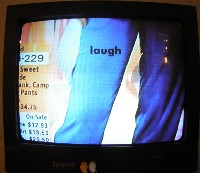
Juliana Forero, a Colombian who resides in Florida, quick cuts in her video “Nature” through a series of commercial stills. Then a solid green screen comes up and holds or else shifts through different shades of green. The greens range from computer kelly green to a bluey tropical shade. Next to the commercials, the greens can almost pass for nature and peacefulness–but of course that’s a big lie (right, “Nature”).
Under the bell jar
We’ve got not one but two artists showing bell jars.
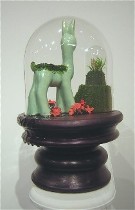
Rebecca Chamberlain puts pretend nature under glass–bell jars within bell jars preserving the ersatz with a cheerful kitschiness that charms with its rueful layers of jokes (left, “Kawaii/Tete a Tete – Twin Series: Deers”).
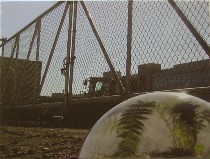
In contrast, Vaughn Bell‘s installation shows a series of Plexiglas domes filled with real plants. He also shows documentation of having placed the terrariums in places denuded of nature (right, “Introduction of a Green Horizon” detail).
Both these artists are about preservation and nature, but Chamberlain’s take is richer. The cultural artifacts she uses–plastic animals, for example–have become what we treasure above the real thing. We are preserving a plastic, manufactured, self-deluded world.
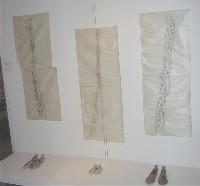
Also of note were the four pieces by Keiko Myamori. The three “Shoe Tree” pieces are shrine-like, offering ritualistic traces of the tracks we leave behind–except tree rubbings, not feet, made the tracks, and our real tracks are embodied in the shoe trees, formerly parts of real trees. The serial numbers on her washi paper made me think of lives and trees felled, a statement about the value of life, be it animal or vegetable (from left to right, “Shoe Tree – woman,” “Small Shoe Tree” and “Shoe Tree – man”).
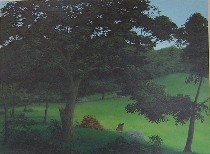
Colin Brant‘s landscape paintings are charmingly unnatural and stunningly green, green, green. Their storybook quality and exaggerated perfection tip Brant’s hand. He’s clearly got something other than mere landscape painting in mind. A man next to me burst out laughing while looking for the yellow orioles in his “Yellow Orioles Warble High in Shadowy Summer Woods” (image, right). The birds are not the only things missing in our real landscapes.
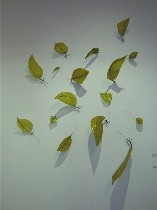 And if you try to find the models in an entymology book for Lisa Murch‘s multi-media dream insects pinned to the wall, you’d be in trouble. The insects are pretty small, mostly around finger length, but they’re larger (and more exotic) than life (left, “Flora & Fauna”).
And if you try to find the models in an entymology book for Lisa Murch‘s multi-media dream insects pinned to the wall, you’d be in trouble. The insects are pretty small, mostly around finger length, but they’re larger (and more exotic) than life (left, “Flora & Fauna”).
Others in the show included Nancy Simonds’ paintings of the color green, Karen Stone’s ecology and death mixed-media pieces, and Paulette Bensignor’s paintings on canvas and on sculpture.
The Color Green is part of The Color Project, a series of color-related shows and events organized by the Klein Gallery at other University City locations, including the University of Pennsylvania Museum (a self-guided tour of red’s cultural significance), International House
(light and dark and color in film) and on Election Day evening, the Community Education Center (blue poetry slam with Spiral Q performance). There’s more info at the Klein link at the top of the post.
The Color Project is part of the second big-thinking, multi-institutional art effort to come out of University City recently (the first was the ICA’s citywide Big Nothing, which was a big something, including more than 35 other venues around town).








